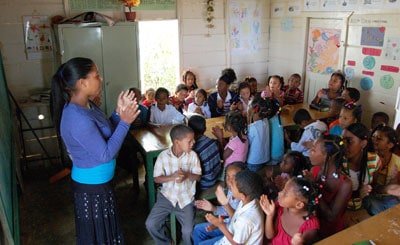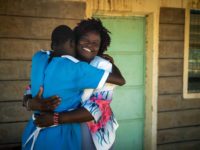The church is essential in helping people escape from poverty, and Elizabeth’s story helps us understand the important role a local church plays in a community.
Elizabeth’s story is similar to the stories of others in her community of Los Montacitos, home to nearly 300 families. This town is located more than 1,200 meters above sea level on the central mountain range in the province of San Juan de la Maguana in southwestern Dominican Republic.
Elizabeth’s father died when she was only 1 year old. All she heard was that he had a sudden headache that killed him, and her mother could not take care of her. That’s when Elizabeth was given up for adoption.
Elizabeth was extremely malnourished and near death when Gabriel and his wife, Santa, received her as a tiny, fragile baby in their hands.
After seven months of care, Elizabeth got well. However, her condition was monitored very closely. In order to help secure her new daughter’s well-being, Santa enrolled Elizabeth with Compassion at just 2 years of age.
The Cristo Es La Solucion Mennonite Evangelical Church became Elizabeth’s second home, and the Los Montacitos Student Center became a place where she was loved and nourished, and where she learned about Jesus and His love for her.
As soon as Elizabeth graduated from the Child Sponsorship Program, she became a tutor for the adolescents at her center. She has since been giving back some of what she has received.
“Whenever I’m working with the children, I remember the time when I came to the center as a child. Before, it was me who needed support; now it’s them who need it. That gives me strength and power to help them.”

Now that Elizabeth has finished high school, she is planning to enter the university in San Juan to become a language teacher for children in the public school in Los Montacitos.
 Many are the youth the church has encouraged to succeed in school, but before the child development center appeared, somebody had to lay the first brick as a living example. That was Sandra.
Many are the youth the church has encouraged to succeed in school, but before the child development center appeared, somebody had to lay the first brick as a living example. That was Sandra.
In 1995, Sandra supervised the development of 70 children in Los Montacitos. At that time, the Child Sponsorship Program was only an extension of another child development center in the neighboring community of Arroyo Cano.
In 1999, Los Montacitos Student Center opened and Sandra became the director.
Sandra got married when she was 15, and she only studied up to grade four of primary school; that’s all the local school offered.
Sandra could have been part of the low education statistic for the Dominican Republic, but as soon as she started working with Compassion, she found herself challenged to be an example for future generations.
Sandra continued her education through the Santa Maria Radio educational program and then went to San Juan weekly until she finished high school and then college.
At present, Sandra is working on a higher education degree in Child Advocacy with Compassion and the National Evangelical University.
After 20 years of continuous hard work for her community, Sandra sees the fruit of her labor.
“We have a lot of youth traveling to San Juan and some of them are in the university. We have some of our tutors traveling to San Juan too.”
The excellence of the center graduates is also inspiring.
Just last year, one of the graduates entered the Leadership Development Program (LDP), and four more students from the child development center have submitted LDP applications.
The Cristo Es La Solucion Mennonite Evangelical Church has been called “Mother of the Community,” and the church considers Los Montacitos its adoptive child.
In the past, children didn’t go to school during the harvest season because their parents used them to help in the harvesting of coffee, beans, green peas, corn and other seasonal crops.
This has changed since staff from the local church spoke with parents about the importance of their children being in school. Staff members have also been to the Ministry of Education regional office, asking the authorities to help promote this mandate among the parents.
There have been many other challenges preventing children from attending school, however.
In 1998, Hurricane Georges tore down the wooden school, which had been built by the parents’ own hands. The construction of the new school began, but for reasons the parents don’t understand, different political leaders have been in office for more than a decade and the school building has not been finished.
Sandra’s house is an ample place and she has lent three of her rooms to the Ministry of Education so the rooms can be used for school so the children won’t lose their school year.
Until recently, there was no electricity in Los Montacitos. In fact, the first television that arrived in the community was Sandra’s in the early 1990s. Farmers with muddy rubber boots sat at her home after a long day of work; they watched TV, played dominoes and shared family stories.
More recently, around 80 percent of the homes in the community have gotten a solar panel so they can at least turn on a few light bulbs at night.
There are no parks or movie theaters in Los Montacitos. Children spend their free time playing marbles. They also play baseball, using a stick and a ball made of a couple of old pairs of socks packed tight in a bundle, or they take green oranges to bat.
Quite recently, the government equipped a new primary health assistance building in Los Montacitos where simple cases like vomiting, diarrhea, headaches and blood pressure problems are addressed. However, they don’t have a lab, and the main hospital in San Juan continues to be the solution in cases of serious illness.
Often, Sandra hosts medical volunteers who come to serve the people of Los Montacitos and who don’t have a place to stay overnight. Her husband has a pickup truck and they always serve their neighbors, taking them down the mountain to the hospital in San Juan, which isn’t an easy task.
It’s a two-hour trip downhill to the main hospital. The road is rocky, tough and full of holes, with a precipice on both sides and steep sections along the way.
Without a connection, the cost to get into San Juan is typically $100. In an emergency someone has to pay that fee all alone. And when it rains, all travel gets canceled.
“People with an asthma have had fits and have died on their way to San Juan,” Sandra reports. “And women have sometimes delivered their babies on our truck before they arrive at the hospital. In fact, we have some of these children in the center.”
After the rainy season is over, the local church in Los Montacitos helps clean the entire community. All rubble from the winds and rainstorms are taken away, the holes in the road are filled, and the woods are reforested to help maintain the environment.
Cristo Es La Solucion Mennonite Evangelical Church is helping build a foundation for the spiritual growth and development of the community. It’s something they’ve been doing well, in various ways, for nearly 50 years.







2 Comments |Add a comment
Thank you for posting this little peak into the life of one that was helped up to better things than just an existence.
I have found these articles written by Adones Martinez to be so informative. They’ve really helped me understand the challenges and successes of the people in the Dominican Republic.
I think I feel a connection to the DR because my own family history mirrors so much of what Adones has shared. My ancestors lived in a town where everyone worked in the mills. The children were in the factories by age 13-14. Men were paid 70-cents for a 10-hour workday. Women were paid 40-cents. And children even less than that. It was impossible for families to get ahead. There was terrible poverty.
What changed things:
1) Getting the kids out of the factories and into the schools. There was no progress until there was education.
2) The churches became a central part of people’s lives and really lifted people up. The churches’ help was both financial and spiritual.
It’s exactly what seems to be happening in the DR through Compassion.
Of course there also had to be strikes, unions and government intervention in the form of child labor laws to make things right in the community. But those things may never have happened without an educated and empowered populace.
I’ll certainly pray for all the children of the Dominican Republic and all of the Compassion folks who are working so hard to help them find success and God’s path for their lives. They seem to have made real progress!